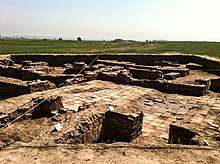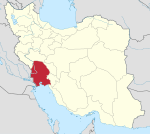Gundeshapur
Gondēshāpūr was the intellectual centre of the Sassanid Empire and the home of the Academy of Gundishapur, founded by Sassanid king Shapur I. Gundeshapur was home to a teaching hospital and had a library and a centre of higher learning. It has been identified with extensive ruins south of Shahabad, a village 14 km south-east of Dezful, to the road for Shushtar, in the present-day province of Khuzestan, southwest Iran.
 Ancient City of Gandhi Shapour | |
 Shown within Iran | |
| Location | Iran |
|---|---|
| Region | Khuzestan Province |
| Coordinates | 32°17′N 48°31′E |
It is not an organised archaeological place as of today, and except for ruins, it is full of remainings like broken ceramics.
Despite the fame, recently some scholars have called Gundeshapur's overall historical importance, specifically, the existence of its hospital, into question.[1]
Rudolf Steiner, the Austrian philosopher, educator and founder of anthroposophy, pointed out the role Gondishapur (or Gundishapur) played in world history.[2][3][4][5]
The town fell into decline after the Muslim conquest of Persia, the city surrendering in 638, however it continued to remain an important centre in the Muslim period. Ya'qub ibn al-Layth al-Saffar, the founder of the Saffarid dynasty, made Gundeshapur his residence three years before his sudden death. His tomb became one of the most prominent sites in the city.[6]
Name
The Middle Persian word Gondēšāpūr (or Gundēšāpūr) is a corrupted form. It may be from wandēw Šāpūr, means "acquired by Shapur",[7] or from Gund-dēz-i Shāpūr, means "military fortress of Shapur",[8][9] or from Weh-Andiyok-Shāpūr, "Better-than-Antioch of Shapur".
In Classical Syriac, the town was called ܒܝܬ ܠܦܛ Bēth Lapaṭ,[10]; in Greek Bendosabora; in Arabic: جنديسابور Jundaysābūr; and in New Persian: گندیشاپور.
The Rise of Gundeshapur
Gundeshapur was one of the major cities in Khuzestan province of the Persian empire. Gundeshapur's administrative district included the neighboring towns of Susa and Mihrijanqadaq, the latter which was actually in a different province.[11]
Most scholars believe Shāpur I, son of Ardeshir (Artaxexes), to have founded the city after defeating a Roman army led by Emperor Valerian. Gundeshapur was a garrison town and housed many Roman prisoners of war. Shāpur I made Gundeshapur his capital.
Shāpur's wife, the daughter of Aurelian, lived in the capital with him. She brought with her two Greek physicians who settled in the city and taught Hippocratic medicine.
In 489, the Nestorian theological and scientific center in Edessa was ordered closed by the Byzantine emperor Zeno, and transferred itself to become the School of Nisibis[12] or Nisibīn, then under Persian rule with its secular faculties at Gundeshapur, Khuzestan. Here, scholars, together with Pagan philosophers banished from Athens by Justinian in 529, carried out important research in medicine, astronomy, and mathematics".[13]
It was under the rule of the Sassanid monarch Khusraw I (531-579 CE), called Anushiravan "The Immortal" and known to the Greeks and Romans as Chosroes, that Gundeshapur became known for medicine and erudition. Khusraw I gave refuge to various Greek philosophers, Nestorian Assyrians fleeing religious persecution by the Byzantine empire.
The king commissioned the refugees to translate Greek and Syriac texts into Pahlavi. They translated various works on medicine, astronomy, astrology, philosophy, and useful crafts.
Anushiravan also turned towards the east, and sent the famous physician Borzouye to invite Indian and Chinese scholars to Gundeshapur. These visitors translated Indian texts on astronomy, astrology, mathematics and medicine and Chinese texts on herbal medicine and religion. Borzouye is said to have himself translated the still popular Indian Pañcatantra from Sanskrit into Persian as Kelile væ Demne.
Many Assyrians settled in Gundeshapur during the Fifth century. The Assyrians were most of all medical doctors from Urfa, which was during that time, home to the leading medical center.[14] Teaching in the Academy was done in Syriac until the city fell to Muslim Arab armies, which destroyed the city and places of learning.[15]
Gundeshapur under Muslim rule
The Sassanid dynasty fell to Muslim Arab armies in 638 CE. The academy survived the change of rulers and persisted for several centuries, by projecting itself as a Muslim institute of higher learning. In 832 CE, Caliph al-Ma'mūn founded the Bayt al-Hikma, the House of Wisdom. There the methods of Gundeshapur were emulated since the House of Wisdom was staffed with graduates of the older Academy of Gundeshapur who had been trained heavily in Indian and some Greek and Iranian medical traditions. It is believed that the House of Wisdom was disbanded under Al-Mutawakkil, Al-Ma'mūn's successor who felt learning conflicted with the information given in the Quran. In addition, the intellectual center of the Abbasid Caliphate had shifted to the Arab stronghold of Baghdad, as henceforth there are few references in contemporary literature to universities or hospitals at Gundeshapur.
Gundeshapur had been major link between Indian and some Greek medicine, because of its previous practices of combining the medical traditions, therefore the transition from earlier ancient civilisations to later Islamic appropriation was more coherent.[16]
The last attested head of the Gundeshapur hospital was Sābur bin Sahl who died in 869. The fate of the hospital after this is unknown.[17]
Recent academic doubts
Some scholars have cast doubts on the existence of the hospital at Gundeshapur by claiming that there are no known surviving Persian sources "that would corroborate the claims that [Gundeshapur] played a crucial role in medical history".[18] It has been assumed that a medical center at Gundeshapur would have resembled the School of Nisibis. What is more likely is there existed a seminary, like the one in Nisibis, where medical texts were read, and an infirmary, where medicine was practiced.[19]
Additionally, Gundeshapur's reputation may have been conflated with that of Susa, a city to the west of Gundeshapur and with which Gundesahur was administratively linked. Ath-Tha'ālibi, a scholar with access to Sassanian royal annals, discussing pre-Islamic Persia, wrote:
Thus, the people of Sūs [Susa] became the most skilled in medicine of the people of Ahwāz and Fārs because of their learning from the Indian doctor [who was brought to Susa by Shāhpūr I] and from the Greek prisoners who lived close to them; then [the medical knowledge] was handed down from generation to generation.[20]
On the other hand, the same source might be another confirmation of the medical reputation of Gundeshapur as Susa may represent the whole local region which included Gundeshapur (as they were administratively linked). This is enforced by the fact that Ahwāz and Fārs, mentioned in the quote for comparison to Susa, were regions as well, an indication that regions were being compared.
See also
- Science in Persia
- List of hospitals in Iran
- School of Nisibis
- Sarouyeh
Further reading
- Elgood, Cyril (1951). A Medical History of Persia. Cambridge: Cambridge University Press.CS1 maint: ref=harv (link)
- Hau, Friedrun R. (1979). "Gondeschapur: eine Medizinschule aus dem 6. Jahrhundert n. Chr". Gesnerus. XXXVI: 98–115.CS1 maint: ref=harv (link)
- Piyrnia, Mansoureh. Salar Zanana Iran. Maryland: Mehran Iran Publishing, 1995.
Notes
- Dols (1987)
- "Anthroposophical Leading Thoughts: The Apparent Extinction of Spirit-Knowledge in Modern Times". wn.rsarchive.org. Retrieved 2016-07-30.
- "Academy of Gondishapur, The - SCHOEFFLER, HERBERT". www.rudolfsteinerbookcentre.com.au. Retrieved 2016-07-30.
- Sease, Virginia; Schmidt-Brabant, Manfred (2003-01-01). Paths of the Christian Mysteries: From Compostela to the New World. Temple Lodge Publishing. ISBN 9781902636436.
- "Aspects of the Occult Significance of the Year 1998 | threeman.org". threeman.org. Retrieved 2016-07-30.
- Alireza Shapour Shahbazi, Lutz Richter-Bernburg. GONDĒŠĀPUR. Encyclopaedia Iranica.CS1 maint: uses authors parameter (link)
- "Gondēshāpūr" in Encyclopaedia of Islam
- "GONDĒŠĀPUR" in Encyclopædia Iranica
- Potts, D. T. (1999). The Archaeology of Elam: Formation and Transformation of an Ancient Iranian State. Cambridge University Press. p. 421. ISBN 9780521564960.
- Thomas A. Carlson et al., “Beth Lapaṭ — ܒܝܬ ܠܦܛ ” in The Syriac Gazetteer last modified January 14, 2014, http://syriaca.org/place/35.
- Frye (1975a), pp. 10–11
- University of Tehran Overview/Historical Events Archived 2011-02-03 at the Wayback Machine
- Hill (1993), p. 4
- "Archived copy" (PDF). Archived from the original (PDF) on 2008-10-02. Retrieved 2008-08-28.CS1 maint: archived copy as title (link)
- Frye (1975b), p. 397
- Frye (1975b), pp. 388–389
- Alireza Shapour Shahbazi, Lutz Richter-Bernburg. GONDĒŠĀPUR. Encyclopaedia Iranica.CS1 maint: uses authors parameter (link)
- Dols (1987), p. 369
- Dols (1987), p. 377
- Dols (1987), p. 378
References
- Dols, Michael W. (1987). "The Origins of the Islamic Hospital: Myth and Reality". Bulletin of the History of Medicine. 61: 367–391.CS1 maint: ref=harv (link)
- Frye, Richard Nelson (1975a). The Golden Age of Persia. London: Weidenfeld & Nicolson.CS1 maint: ref=harv (link)
- Frye, Richard Nelson, ed. (1975b). The Cambridge History of Iran. 4. Cambridge: Cambridge University Press.CS1 maint: ref=harv (link)
- Hill, Donald (1993). Islamic Science and Engineering. Edinburgh: Edinburgh University Press.CS1 maint: ref=harv (link)
